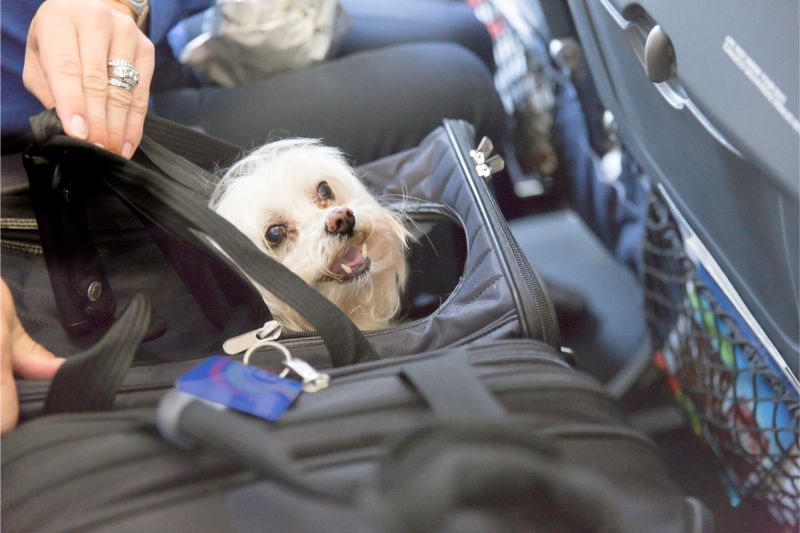The Keys to Successful Airline Travel with Pets

Traveling with a pet can be fun, but it also presents some significant challenges. Since we know airline travel is extremely stressful for pets, there are things you can do to make the big day go more smoothly and safely for them.
Airline travel with pets can be a lot of work. But with planning, preparation and a little help from your Lone Tree Veterinary Medical Center team, you and your pet will be jet-setting off into the sunset in good style.
Talk To Your Veterinarian
The first step in preparing for airline travel with your pet is to bring them in for a physical exam. This ensures your pet is healthy and has the necessary vaccinations. For overseas travel, a veterinary health certificate is required. This is prepared by your veterinarian. Entrance requirements for pets can vary widely between countries and change without notice. Contact us as soon as you know your destination so we can start the process. Meeting all requirements for foreign travel can take several weeks or even months.
Airline Rules and Regulations
Due to past fatalities involving pets traveling by plane, several major airlines have updated their rules and regulations for pet travel. It’s essential to research in advance to determine which airline best meets the needs of you and your pet. Consider the following factors:
Pet Carriers
The list of requirements for your pet’s carrier is long. Be sure that your carrier meets all listed requirements for air travel with the airline. Make sure you’ve followed the instructions on pre-flight feeding, water, and labeling on the carrier.
Layovers
New regulations limit the number of cities pets can be routed through to reduce the risk of them being misplaced. Seek to always schedule a direct flight and make sure your pet is on the same flight as you.
Crate Training
Whether your pet will be staying in the airplane cabin or the cargo hold, it’s crucial that they are well-adjusted to and comfortable in their carrier. Make sure your pet meets the requirements for traveling inside the airplane cabin. It’s polite to ensure that they are well-behaved and under your control for the comfort of other travelers.
Breed Regulations
Some airlines have flight restrictions on certain breeds due to health concerns. Short-nosed pets, such as Pugs, Persian cats, and bulldogs, are often affected because their shortened airways. Be sure to research these restrictions before making your reservations.
Main Cabin and Cargo Hold
Airline travel, whether in the main cabin or the cargo hold, can be extremely stressful for any pet. The noisy, chaotic environment of an airport or the unfamiliar setting of a cargo hold can exacerbate existing health problems or lead to new ones. Pets are more sensitive to sights, sounds, and smells than humans, which can leave them frightened and agitated. Consider your pet’s needs and sensitivities when deciding if airline travel is a suitable option.
Service and Therapy Animals
Recent changes have tightened regulations for service and therapy animals traveling in the cabin with their handlers. Ensure you are aware of the required documentation. This may include medical documentation, a veterinary health certificate, and a certificate of training. Inquire whether there is a separate fee or if you need to purchase a seat reservation for your pet.
Traveling During Hot or Cold Months
Many airlines place restrictions on pets traveling in the cargo hold during extreme hot and cold weather, often allowing travel only during the spring and fall months. Some airlines prohibit pet cargo travel to Phoenix, Tucson, Palm Springs, or Las Vegas between May 1st and September 30th. There are inherent risks to pets when they travel in cargo, so every precaution should be taken to ensure their safety and comfort. Research the airline’s policies and protocols. Consider where your pet will be taken when offloaded from the plane. Will the area be safe and temperature-controlled? How long will your pet be there before you can pick them up? You don’t want your pet left on a tarmac, in a hot or cold holding area, or in any unattended place.
Private Pet Transport Airlines
A few small private airlines have begun specializing in transporting pets. The pets are monitored by a trained attendant during flight. Although considered a luxury service, it could easily be the ideal choice to ensure your pet’s comfort and safety.
When To Avoid Air Travel
If your pet is ill, recovering from an illness, in a weakened state, recently had surgery, or is older or disabled, consider choosing another mode of travel. If you’re unsure, discuss your pet’s health status and the safety of air travel with your veterinarian.
Safe Airline Travel with Pets
- Make sure your pet is wearing its collar and ID tags.
- Update its microchip.
- Securely attach a current photo of your pet to its carrier.
- Carry a current photograph of your pet
- Do not feed your pet for 4-6 hours before your trip.
- Exercise your pet right before you leave for the airport.
- Pack plenty of water for the trip to the airport and for the flight.
- Allow potty breaks upon arriving at the airport and prior to entering the terminal.
- Pets can and do get neglected during airline travel. Notify airline staff of your pet’s presence and check in on your pet often.
Speak Up If You See Something
Don’t hesitate to complain if you witness the mishandling of an animal—either yours or someone else’s—at any airport. Ask to speak with the manager of the section where the incident occurred and report mishandling both in person and in writing.
If you’re thinking of traveling by air with your pet, please contact our staff for more information or to schedule an appointment with our veterinarian. We are always happy to answer your questions about traveling with a pet.



